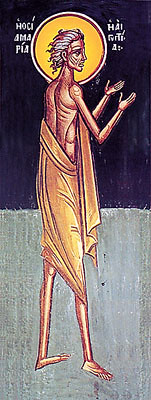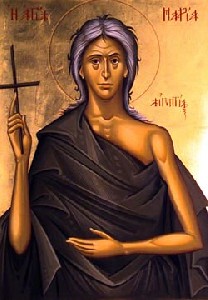Psalm 78:23-29
Ephesians 4:1-16
John 6:24-35
In the past two weeks we have heard about compassion fatigue and of a God without limits. We have heard about the availability of the miraculous to us if we come and offer what we have. We have I think been wrestling with God as our provision. Tonight Jesus comes to us and says “I am the life of the world, I am the bread come down from heaven.” You will also undoubtedly have seen the two icons printed on your service leaflet are the icon of St. Mary of Egypt, who lived in the desert of Palestine alone for 40 years, she said she was fed by the Word of God.


I will get to her story in a moment but her story stands in contrast to the story of the Israelites and manna; she went to be freed from her cravings and was provided for while God provides for the Israelites even as they distrust and crave after what they had in Egypt. Our texts today and the story of St Mary of Egypt ask us to contemplate the relationship between belief (trust, faith) and eating. What do we take into our bodies, what do we truly trust to sustain us, do we truly believe Jesus?
Our Gospel continues where we left off last week the crowd that has been fed by the multiplication of loaves and fishes have sought out Jesus and found him and so begins a debate over the meaning of the miracle. Both Jesus and the crowd see the miraculous even it is also a sign, the miracle points to the work God is doing and has done. The question is what does the miracle mean, to what does it point. Unfortunately I don’t tend to think of the miraculous has having this sort of meaning. Miracles are just things that happen that make a difference, save a life etc. but to have meaning beyond that... it is unusual for us to run there because at times such interpretation can be dangerous. Miracles in the Gospels have this sort of significance, they don’t just signify God’s power, they aren’t proofs of God’s existence or that Jesus is God in this raw way but they do show us God and who Jesus is, because they are signs. This particular miracle is a sign about the convergence of eating and belief, the sign of the feeding of the five thousand should make us look for what we eat to believe and what we believe in order to eat. We are invited to see that the source of life is present to us, and will sustain us, like the manna given to the Israelites in the desert.
Those who have chased after Jesus are now arguing with him about the meaning of the miracle. They correctly see that the miracle is related to the manna sent to the Israelites to feed them while the wandered 40 years in the desert. However, for them Jesus’ multiplication of loaves is a shadow of this older miracle and sign, and so they expect that God through Jesus might be doing something similar. Jesus critiques this understanding of the miracle. They have in mind a temporary fix, they want God’s provision exactly like or at least similar to the manna in the desert in their own time.
The mistake isn’t in the connection betweent the manna in the desert the multiplied loaves and fishes, their mistake is to think that the multiplication of loaves and fishes points back to the manna rather than the manna and loaves and fishes as signs of something else.
So Jesus says “Yes the bread that comes down from heaven, but Manna was just a sign of the true bread from heaven that gives life to the world. I am the bread that comes down from heaven, and gives life to the world.”
I would like to tell a story of a woman who lived in the 6th century. She is known as St Mary of Egypt. She ran away from her home in an Egyptian village to go to Alexandria as a 12-year-old girl: A country girl off to the big city, seeking excitement and new experiences. Once in Alexandria she begged for food and spun flax and enjoyed sleeping around, today we might even say that she was a sex addict. Though she never used her sensuality for money it did get her other things, like passage to Jerusalem with pilgrims going to see the True Cross. She wasn’t interested in the pilgrimage or the Cross-, but further adventure and a new place to continue to explore and express her sexual desires. But she is inexplicably drawn to the church where the True Cross was displayed and then is prevented from entering the nave by an unseen force. Eventually she stops trying to get in and contemplates an icon of the Virgin Mary in the narthex and is overcome with an awareness of her sin and repents. She is then able to enter the nave and venerates the True Cross. As she leaves she prays to the Virgin and she hears a voice say “Go into the desert beyond the Jordan and you will be free.” As she leaves the narthex she is given three coins by a passerby with these three coins she buys three loaves of bread and heads to the Basilica of St John the Forerunner on the Jordan river. There she receives communion and then enters the desert. She lives there for 40 years without encountering another person until a certain priest and monk Zosimas chases after her after she inadvertently crosses his path. She knows who he is though she has never seen him, but she has avoided all contact for most of her life and she is not sure what will happen and after all she is without any clothes. The priest catches up to her and upon her request gives her his outer cloak, and then they talk about who should bless whom. Zosimas recognizes in her a great saint, she sees herself as a humble Christian in need of the blessing from the priest. Eventually they both bless each other, and she prays for him and the world and then she recounts her story to Zosimas, how she was before she came to the desert and how she lived and struggled in the desert. How after receiving communion she had only three loaves of bread and how they lasted though hard for 17 years, the rest of the time she has lived on plants found in the desert and been without cloths. When the priest asks Mary how it is she has lived like this she says that it was the Word of God that was her food and clothing. Christ had sustained her all these years, and now Marry asks the Priest to come to her in a year’s time bringing the Eucharist. And he does and then Zosimas sees her walk on water to cross the Jordan and as she receives communion she cross over the Jordan. She died that night across the Jordan after taking communion the second time.
There are parallels with chapter 6 of John and the story of the Israelites wondering in the desert; there is walking on water, 40 years in the desert, like the Israelites, she is sustained in the desert. The Word of God sustains her, and by the Eucharist she received before entering the desert.
We know the story of St. Mary of Egypt because Zosimas saw that her very existence was a miracle and a sign. And so he insisted on her telling him her story even as she insisted that it was unremarkable. From here perspective Has she not done what all Christians do, trusted believed fed upon Christ, the bread of heaven. And from the Priest Zosimas’ perspective: Was it not also true she had done what every Christian does in the most extreme of circumstances and been sustained in ways beyond any “normal” or usual call.
In part the story of St. Mary of Egypt is a story about the relationship between faith and sustenance, for the body and soul. That is the relationship between belief/faith and eating. The old Protestant argument around chapter 6 of John and its relationship to the bread and cup of communion is to emphasize belief with out eating. There is nothing to eating, believe, have faith in Christ that is the eating Jesus is talking about here. Yet, doing so is the mirror image of those who have followed after Jesus because of the miracle of feeding the five thousand, they don’t believe in Jesus, they just want to be fed, they also have divorced eating and believing. Belief is sustenance, but to believe without eating? We eat bread and drink wine believing we take into ourselves the bread of heaven he who gives life the World. For Christ to be our sustenance we must eat and believe. The multitude apparently ate without believing and all they saw was someone who could fix their temporal problems, and then they believe that the multiplication of the loaves and fishes is a sign like that of the manna in the desert but they wish to believe without having to eat. Mary of Egypt eats and believes and believes and is fed. In faith she enters the desert but not before receiving the bread and wine of the Eucharist. Believing God she trust her self to the provision of God and God’s Word. Mary of Egypt in an extreme way shows us how faith can be our sustenance while also demonstrating we must eat to believe. Yet even as I say this I hear part of myself say but, but surely not. There is so much to this story to question, if not reject and yet Jesus says the two, believing and eating, go together as well, yet it is hard to accept.
Why is this? Because we are like the fed multitude who refuses to see because what they saw was offensive. They cannot see God in their presence in human form, God is to stay out there somewhere. They want to be fed and then to contemplate God. But God the very life of the world in their midst, saying that to believe is to eat and to eat is to believe, is shocking. It breaks down our categories: sure I need to eat and God will provide me with food, and sure my soul needs to be sustained by contemplating the Torah the word of God through mediating on who God is, but to take God into myself, to have God be my food quite literally, as God was for St. Mary of Egypt, that says too much! How can this be?
Take eat this is my Body…. Drink from it, all of you, this is my blood…”. There is no room for dividing belief and eating. “I am the Bread of Life,” says Jesus will you come do you believe. Do you trust and will you eat? Amen
No comments:
Post a Comment